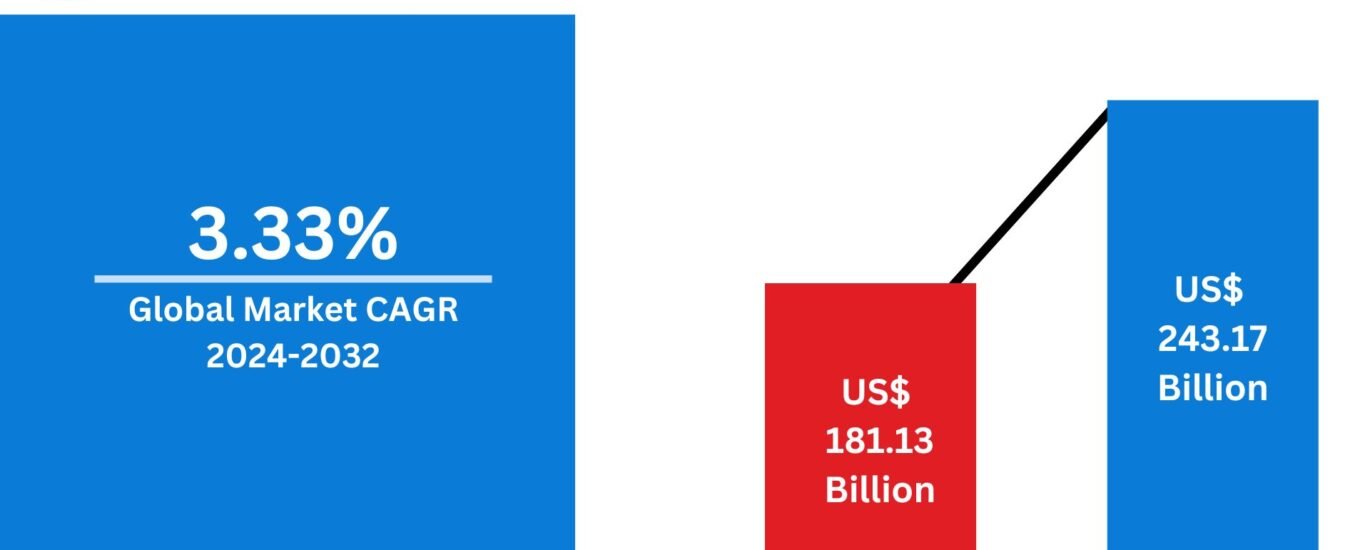Global Seafood Market – Trends, Forecast, and Growth Insights (2024-2032)
Renub Research Releases Comprehensive Global Seafood Market Report
Global Seafood Market Expected to Reach US$ 243.17 Billion by 2032
Renub Research, a leading market research and consulting firm, has released an in-depth analysis of the global seafood market, forecasting a growth from US$ 181.13 billion in 2024 to US$ 243.17 billion by 2032, at a Compound Annual Growth Rate (CAGR) of 3.33%. This comprehensive report explores key growth drivers, challenges, and regional trends influencing the market’s development.
Market Overview: Health, Sustainability, and Aquaculture Driving Growth
The global seafood market is benefitting from increased consumer health consciousness, the rise in seafood consumption, and a growing awareness of its nutritional value, including omega-3 fatty acids, lean proteins, and essential vitamins. Pescetarianism, an increasing trend of adopting seafood in diets, further bolsters the market growth. Countries with well-established seafood consumption cultures, such as those in Asia and Europe, have seen a lower prevalence of cardiovascular diseases, partially due to the omega-3 benefits associated with seafood.
Rising Aquaculture Industry and Increased Fish Farming
The seafood market is also supported by the rapid expansion of aquaculture, providing a sustainable supply of fish and other seafood products. The practice of fish farming helps reduce the strain on wild fish stocks and ensures steady product availability. Innovative aquaculture solutions, such as Innovasea’s Realfish Pro launched in 2022, allow fish farmers to remotely monitor and optimize farming operations, contributing to the efficient growth of the industry.
Health-Conscious Consumer Trends Boosting Seafood Demand
As the global population grows and disposable incomes rise, seafood is becoming a key component of the protein-rich diets preferred by many. The U.S., China, and Brazil are major markets for seafood, with strong consumption trends driven by a shift towards healthier dietary choices.
Challenges: Overfishing and Environmental Sustainability Concerns
Despite the positive growth trends, the global seafood market faces significant challenges, particularly overfishing, which threatens marine biodiversity and disrupts ecosystems. Sustainability practices are becoming increasingly essential, with consumers and governments pushing for responsible fishing and more sustainable production practices. However, implementing such practices can be costly, and many small-scale fisheries struggle to meet these demands.
Key Segments in the Global Seafood Market
The global seafood market is segmented based on form, type, and application:
- Form: Fresh, Frozen, Ambient, and Canned & Processed Seafood
- Type: Fish, Crustaceans, Molluscs, and Other Seafood
- Application: Retail, Institutions, and Food Service
Regional Insights: Key Markets in the Global Seafood Industry
- United States: The U.S. remains a major player in the seafood market, with increased demand for fish, shellfish, and crustaceans. Health-conscious consumers and imports from countries like Canada and China fuel demand.
- China: As the world’s largest producer, consumer, and exporter of seafood, China’s demand for premium seafood products such as shrimp, lobster, and salmon continues to grow.
- Brazil: The Brazilian seafood market is expanding due to growing awareness of seafood’s health benefits, although logistical challenges persist.
- Saudi Arabia: The government’s Vision 2030 initiative is driving local seafood production growth to reduce reliance on imports, especially shrimp and grouper.
Conclusion: A Booming Industry with Sustainable Practices
The global seafood market continues to grow driven by consumer demand for healthier, protein-rich foods, technological advances in aquaculture, and the increasing popularity of frozen seafood. However, ensuring sustainability and minimizing environmental impact remain key challenges. The adoption of responsible fishing practices, investment in aquaculture, and expanding supply chains will be essential for the industry’s long-term success.
For more details, you can access the full report at Renub Research’s website.
New Publish Reports
- North America Frozen and Canned Seafood Market Size and Share Analysis – Growth Trends and Forecast Report 2025-2033
- Saudi Arabia Seafood Market Size and Share Analysis – Growth Trends and Forecast Report 2025-2033
- United States Seafood Market Forecast Report by Form (Fresh, Frozen, Ambient, Canned & Processed Seafood), Type (Fish, Crustaceans, Molluscs, Others), Application (Retail, Institutions, Food Service) States and Company Analysis 2024-2032.
- South Korea Seafood Market Size and Share Analysis – Growth Trends and Forecast Report 2024-2032
FAQs: Global Seafood Market
- What is the expected growth rate of the global seafood market?
The global seafood market is expected to grow from US$ 181.13 billion in 2024 to US$ 243.17 billion by 2032, at a CAGR of 3.33%. - What are the main factors driving the growth of the global seafood market?
Key drivers include rising health consciousness, increased seafood consumption, the expansion of aquaculture, and growing demand for protein-rich diets globally. - Which regions are driving the demand for seafood?
The demand for seafood is particularly strong in the U.S., China, Brazil, and Saudi Arabia. These regions have seen significant growth due to health-conscious diets and increased disposable income. - How does aquaculture impact the global seafood market?
Aquaculture helps meet the rising demand for seafood while alleviating pressure on wild fish stocks. It ensures a sustainable and consistent supply of fish, reducing the impact on marine ecosystems. - What are the challenges faced by the seafood industry?
Challenges include overfishing, sustainability concerns, supply chain disruptions, and rising transportation costs. Ensuring environmental sustainability while meeting growing demand is a major issue for the industry. - Which seafood products are seeing the highest demand?
Fish (such as salmon, tuna, and cod), crustaceans (including shrimp and lobster), and molluscs are among the most consumed and popular seafood products. - How is the seafood retail market evolving?
The seafood retail market is evolving with growing consumer demand for fresh, quality seafood, especially through supermarkets, online platforms, and specialty stores. E-commerce and home delivery services are expanding access to a wide range of seafood products. - How is climate change affecting the seafood market?
Climate change impacts marine life, causing shifts in fish stocks and distribution patterns. It also poses challenges for aquaculture practices, affecting fish health and production. - What are the key trends in the frozen seafood market?
Frozen seafood is gaining popularity due to its convenience, longer shelf life, and all-year-round availability. Flash-freezing and IQF methods help preserve freshness and nutrients, making frozen seafood a preferred choice for many consumers and retailers. - How does the U.S. seafood market compare to other countries?
The U.S. seafood market is one of the largest, driven by high consumption of fish, shellfish, and crustaceans. It heavily relies on imports, with countries like Canada, China, and Vietnam being major suppliers. - What is the role of sustainability in the global seafood market?
Sustainability plays a critical role in shaping consumer preferences, government regulations, and industry practices. Eco-certifications, traceability programs, and sustainable fishing methods are becoming increasingly important to ensure long-term market stability. - What is the future outlook for the seafood market?
The seafood market is poised for continued growth, driven by consumer demand for healthier diets, innovative aquaculture solutions, and increasing seafood availability worldwide. Sustainability efforts and responsible sourcing will be crucial for the market’s future success.






